Many thanks to Pavel Lebedev for provided by Nikon DX AF Fisheye Nikkor 10.5mm 1: 2.8G ED. Here it is album with photos.
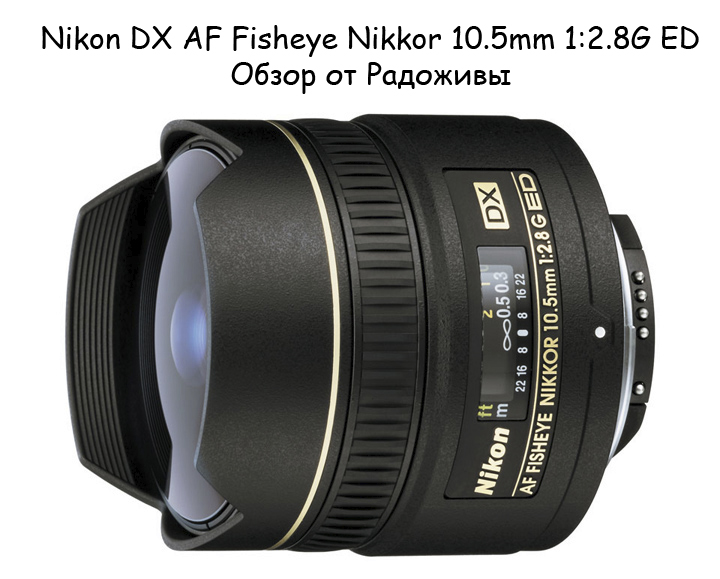
Review Nikon DX AF Fisheye Nikkor 10.5mm 1: 2.8G ED
Nikon DX AF Fisheye Nikkor 10.5mm 1: 2.8G ED is a fisheye lens for Nikon DX cameras. The lens gives a huge viewing angle equal to 180 degrees diagonally. And, of course, Fisheye has the strongest barrel distortion, which helps to create unusual photos. EGF lens is 16mm. Thus, on Nikon DX cameras, this 'cropped' Nikon DX Fisheye 10.5 / 2.8G is an analogue of a full-length lens Nikon AF Fisheye Nikkor 16mm 1: 2.8D.
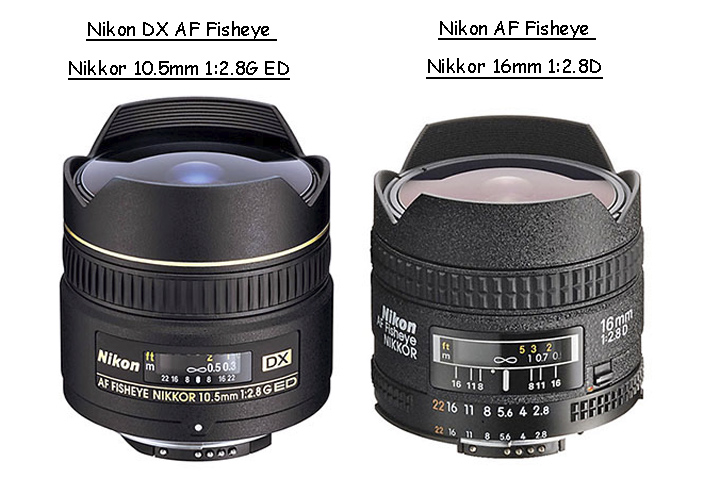
Cropped and full-length fish. The front lens of these lenses is not very convex.
Nikon DX Fisheye 10.5 / 2.8G was launched in Japan in the summer of 2003, while there were no Nikon DX cameras without an integrated focus motor, and the first non-motor camera Nikon D40 appeared already in 2006. In this regard, the Nikon DX Fisheye 10.5 / 2.8G does not have a built-in focus motor. A camera with support is required for convenient operation with this lens. AF optics. You can find the exact list of cameras that Nikon DX Fisheye 10.5 / 2.8G will work with in the pro section AF, AF-S, AF-I lens types. Strange, but out of the entire series of DX lenses, the Nikon DX Fisheye 10.5 / 2.8G is the only lens without an integrated focus motor, and this is not very good, because owners of non-motor cameras like Nikon D5200, D3200 etc. have to use it without autofocus capability. The situation is aggravated by the fact that it is already 2015, and AF-S modifications of this lens have not been released. In general, Nikon DX Fisheye 10.5 / 2.8G is the only native fisheye lens for Nikon DX cameras.
Nikon DX AF Fisheye Nikkor 10.5mm 1: 2.8G ED on its case has gold ring and applies to lenses top leveland also included in the list of professional equipment Nikon NPS. A complete list of Nikon DX professional lenses can be found. here.
Main technical characteristics of Nikon DX AF Fisheye Nikkor 10.5mm 1: 2.8G ED:
| Review Instance Name | Nikon DX AF Fisheye Nikkor 10.5mm 1: 2.8G ED |
| Basic properties |
|
| Front Filter Diameter | the lens does not use front filters |
| Focal length | 10.5 mm, the lens gives a viewing angle of 180 degrees along the diagonal of the frame. |
| Zoom ratio | 1 X (this is a fixed lens without the ability to change the focal length) |
| Designed by | for digital cameras Nikon DX |
| Number of aperture blades | 7 rounded petals |
| Tags | focusing distance in meters and feet, bayonet mount mark, depth of field scale for F / 8, 16, 22 |
| Diaphragm | from f / 2.8 to f / 22. The lens is deprived of the aperture control ring, control is via the camera menu (G - lens type) |
| MDF | 0.14 m, maximum magnification unknown |
| The weight | 305 g |
| Optical design | 10 elements in 7 groups, 1 ED element (shown in yellow on the optical diagram).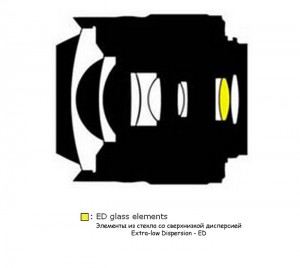 The image is clickable. The image is clickable. |
| Lens hood | built-in, fixed |
| Manufacturer country | MADE IN JAPAN |
| Period | From July 2003 to the present |
| Instructions | View -> |
| Price |
Auto focus on the lens is fast. The focus ring is rubberized and rotates approximately 60 degrees. There is no focus mode switch on the lens body and in order to switch to manual focus mode, use the switch near the camera mount. A very nice feature of the lens is very small minimum focusing distance, it is only 14 cm... When photographing at close range, you can touch the subject with the lens. But the lens does not have internal focusing - when focusing, the front lens moves slightly forward and backward.
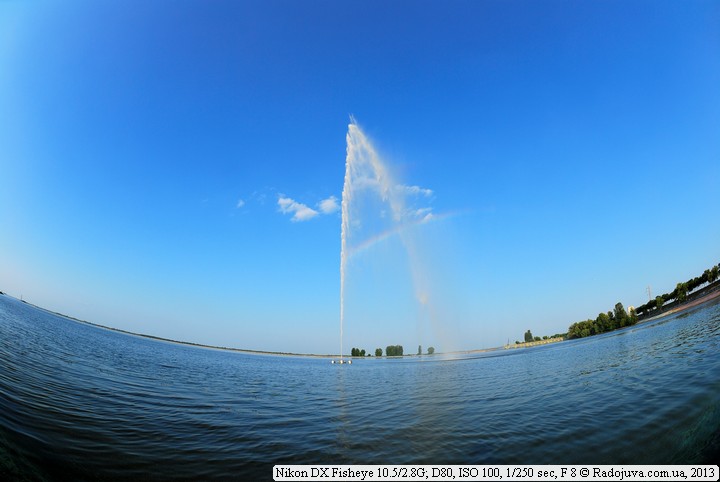
Distortion on Nikon DX Fisheye 10.5 / 2.8G
The lens has a focusing distance scale that 'infinity starts' after 0.5 meter. Therefore, such a lens will not be particularly difficult to use for owners of junior non-motorized Nikon cameras. The lens has a depth of field scale for F / 8, F / 16, F / 22. The diaphragm has 7 blades. Nikon DX Fisheye 10.5 / 2.8G also boasts a good aperture in f / 2.8. Given the very short focal length and good aperture, this lens can be easily take off in low light conditions.
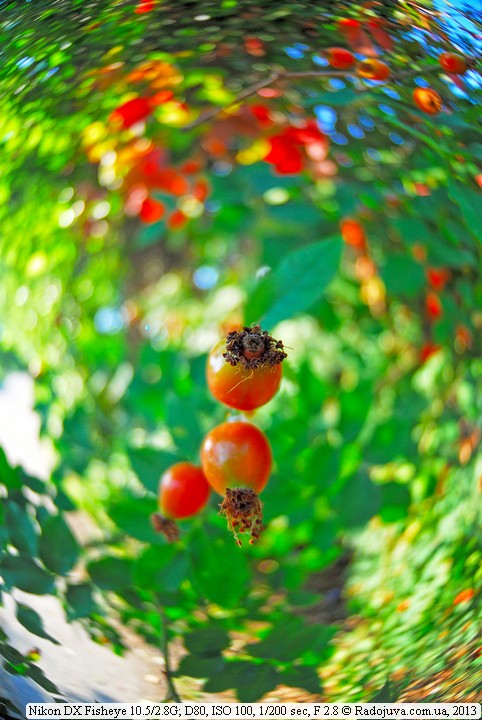
Background on Nikon DX Fisheye 10.5 / 2.8G
Nikon DX Fisheye 10.5 / 2.8G - actually turned out compact small lens. In size, it is about the same as Nikon AF-S Nikkor 50mm 1: 1.4G... The lens itself is very well made, with a metal mount and a built-in hood. Weight - about 300 g. Attention: Screw-on filters cannot be used with Nikon DX Fisheye 10.5 / 2.8G. The front cover just fits tightly on the lens.
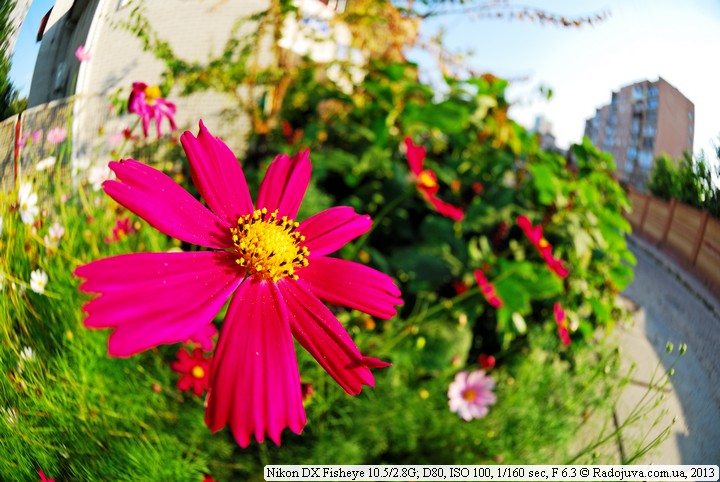
Macro on Nikon DX Fisheye 10.5 / 2.8G-5-mm-fisheye-sample-4
Sample Photos
My Nikon DX Fisheye 10.5 / 2.8G creates a very sharp image. In the center of the image, very good sharpness is already available with F / 2.8. The lens well tolerates side and back light. On closed apertures, Nikon DX Fisheye 10.5 / 2.8G turns bright light sources into 14-beam stars (example) I want to note an interesting nuance: when focusing at short distances, the lens 'twists' the background very strongly. The lens suffers from freezing (aberrations in the blur zone), which color the contrasting elements in the photo in purple (example).
My impressions
Nikon DX Fisheye 10.5 / 2.8G is a very good lens, but you need to know how to use a fisheye lens. Often a fish-eye lens is bought to 'play around', after which it gathers dust on the shelf. Therefore, before buying, I advise you to try somewhere to shoot with a fish-eye and decide whether such a lens is needed on the farm.
Using this lens, you can create very interesting and unusual photos with a game of perspective. For owners of cameras without a motor, I would recommend Samyang 8mm F / 3.5 AE, it costs half the price of Nikon DX Fisheye 10.5 / 2.8G. For those who want the widest possible viewing angle without strong distortion, good aperture and auto focus on all DX cameras - I recommend looking to the side Tokina AT-X 116 PRO SD 11-16mm F2.8 (IF) DX II.
Prices
The real prices for the Nikon DX Fisheye 10.5 / 2.8G lens in popular online stores can be viewed at the following links:
The cost of the Nikon DX Fisheye 10.5 / 2.8G lens can also be found in the price block located below:
Comments on this post do not require registration. Anyone can leave a comment. Many different photographic equipment can be found on AliExpress.
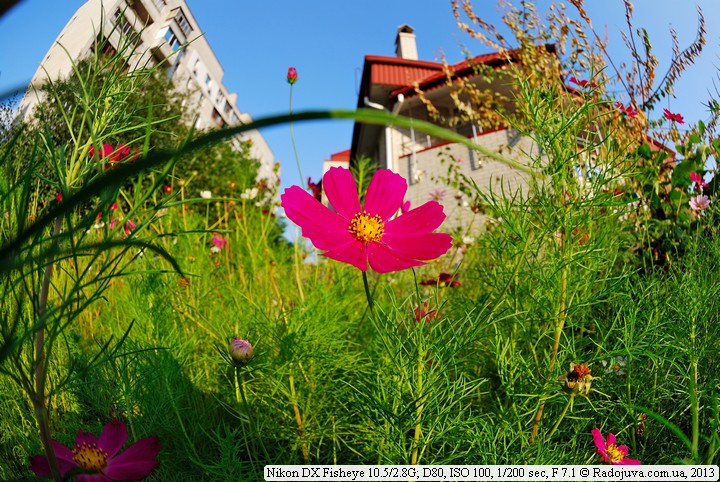
Games with perspective on Nikon DX Fisheye 10.5 / 2.8G-5-mm-fisheye-sample-4
Alternatives
Below is a list of all the features with automatic focus support for SLR cameras with a full-format or APS-C sensor, which can give an angle of view on cropped cameras (cameras with an APS-C sensor) 180 degrees:
Tokina:
- Tokina 107 Fisheye 10-17 mm F3.5-4.5DX AT-X (versions for Canon and Nikon)
- Tokina 107 Fisheye 10-17 mm F3.5-4.5 DX NH AT-X (versions for Canon and Nikon, can work at full frame)
- Tokina 107 Fisheye 10-17 F3.5-4.5 DX AT-X V NH (Canon only)
Sigma:
- Sigma 4.5 mm 1: 2.8 EX DC HSM Circular Fisheye (versions for Canon, Nikon, Sigma and Sony / Minolta)
- Sigma 8 mm 1: 3.5 EX DG Fisheye (can work at full frame, versions for Canon, Nikon and Sigma)
- Sigma 10 mm 1: 2.8 DC HSM Fisheye (versions for Canon, Nikon, Sigma, Sony / Minolta and Pentax)
Nikon:
- Nikon DX AF Fisheye Nikkor 10.5 mm 1: 2.8G ED
- Nikon N AF-S Fisheye Nikkor 8-15 mm 1: 3.5-4.5E ED (can work at full frame)
Canon:
- Canon Fisheye Zoom Lens EF 8-15 mm 1: 4.0L USM (can work at full frame)
Pentax:
- SMC Pentax-DA FISH-EYE 1: 3.5-4.5 10-17 mm ED [IF] (Pentax 10-17) (most likely optically identical Tokina Model 107)
- HD Pentax-DA FISH-EYE 1: 3.5-4.5 10-17 mm (most likely optically identical Tokina Model 107)
Samsung / Schneider-Kreuznach:
- Samsung Zoom Lens Fisheye D-Xenon 10-17 mm 1: 3.5-4.5 AL (most likely optically identical Tokina Model 107, Pentax only)
- Schneider-Kreuznach D-Xenogon 1: 3.5-4.5 10-17 mm ED AL (most likely optically identical Tokina Model 107, Pentax only)
Do you know more similar lenses? Or do you have experience with any of them? Then be sure to share your experience in the comments).
An accurate list of all Nikon DX Nikkor lenses
- 10.5 mm/ 2.8G AF Fisheye [gold ring]
- 35 mm/1.8G AF-S
- 40 mm/2.8G AF-S Microphone
- 85 mm/3.5G AF-S VR Microphone
- 10-20 mm/4.5-5.6G AF-P VR
- 10-24 mm/3.5-4.5G AF-S
- 12-24 mm/4G AF-S [gold ring]
- 16-80 mm/ 2.8-4IN AF S VR [gold ring]
- 16-85 mm/3.5-5.6G AF-S VR
- 17-55 mm/2.8G AF-S [gold ring]
- 18-55 mm/3.5-5.6G AF-S [black / silver]
- 18-55 mm/3.5-5.6GII AF-S [black / silver]
- 18-55 mm/3.5-5.6G AF-S VR
- 18-55 mm/3.5-5.6GII AF-S VR
- 18-55 mm/3.5-5.6G AF-P
- 18-55 mm/3.5-5.6G AF-P VR
- 18-70 mm/3.5-4.5G AF-S
- 18-105 mm/3.5-5.6G AF-S VR [Thailand / China]
- 18-135 mm/3.5-5.6G AF-S
- 18-140 mm/3.5-5.6G AF-S VR [Thailand / China]
- 18-200 mm/3.5-5.6G AF-S VR [Japan / China]
- 18-200 mm/3.5-5.6GII AF-S VR
- 18-300 mm/3.5-5.6G VR
- 18-300 mm/3.5-6.3G VR
- 55-200 mm/4-5.6G AF-S [black / silver, Japan / China]
- 55-200 mm/4-5.6G AF-S VR
- 55-200 mm/4-5.6GII ED VR
- 55-300 mm/4.5-5.6G AF-S VR
- 70-300 mm/4.5-6.3G AF-P
- 70-300 mm/4.5-6.3G AF-P VR
Conclusions
Nikon DX AF Fisheye Nikkor 10.5mm 1: 2.8G ED is the only native fisheye lens for Nikon DX cameras that offers 180 degrees of coverage. Lens very good optically and mechanically, has amazing MDF, maximum aperture F / 2.8. Among the disadvantages: there is no built-in focusing motor and there is no way to use filters.
Material prepared Arkady Shapoval. Training/Consultations | Youtube | Facebook | Instagram | Twitter | Telegram



























Arkady, could you post raw photos without twisting the colors? It is not clear what kind of pattern the lens itself gives, because of the lifted colors, the contrast is lost, especially on the red ones.
Due to the huge weight of the original RAWs, I do not publish them. Here RAW developed through ViewNX, added D-lighting, on the Nikon D80 camera there is a correction of color saturation +2.
Arkady, without saturation correction, you don't need RAW. The camera raises the saturation worse than the user and it is easier for me to wind up the color than to remove it later. It's just that for old manual lenses such a “overclocking” of color was appropriate, but for new ones it is already clearly redundant.
The taste and color of all markers are different.
In Radozhiva, all examples of pictures in all reviews are wound and the same. Wedding attendants are such wedding attendants.
The sheer weight of the Nikon D80's original RAWs? This is the first time I've heard such an excuse. Their size for d80 is 7-8 MB, depending on the scene - any Internet user can download this today.
Most likely you misunderstood. I mean that 25 photos from this article will weigh about 200 MB and it’s extremely unprofitable for me to pay for Radozhiva’s small hosting.
Again you are here with criticism ... :) It's good, come back often. Not a single real site can live without people who hate it, but suffer and read ... :)
Ptiburdukov, I despise you.
The novel is right. Photos full of shit. We must do as he says!
No one can tell the author how and what to do!
1) command what and how to do elsewhere
2) you are not a shareholder of this (personal) blog
3) I'm sure you yourself have learned a lot from the articles of Arkady.
Arkady! Thank you from loyal readers)))
Thanks. Still, about the saturation, I think.
Think would be grateful. I don't appreciate the artistic component - it's too subjective. But the blog is from photography equipment. I cannot adequately assess the color rendition of the lens from these photos and compare it with other lenses that were reviewed earlier.
With the correct processing, the colors are always lifted up not stupidly "in the forehead", but through the brightness mask, but for especially bright colors also with the use of additional techniques. And so it goes neither here nor there - too little for good processing, but already a lot for the correct display of the lens characteristics.
You can find fault with the table. As for the color rendition - why doesn't anyone ask what kind of BB is in the pictures? And he is damn different. But this is a very important aspect. By the way, Ken writes everywhere that on D80, D200 he uses enhanced Saturation +, and no one will pick on, I do the same, because the basic settings get a very boring picture. But the red on the D80 really hits the eyes, the peculiarity of the camera is as follows. The issue of color reproduction is very difficult, given that I constantly shoot with different cameras, it is very difficult to achieve any one level, you must understand these subtleties.
I will answer here, it does not work out below.
I'll fix the BB somehow, it's not a problem. Even difficult cases with illumination of several light sources with different temperatures are corrected. But I will not be able to restore the details in the red channel after oversaturation due to the inferior intra-camera algorithm. You can lower the saturation, mix in the green, the channel, darken a quarter tone (the Hemholtz-Comrausch effect), then separate the colors a little with curves in Lab (increasing not the color saturation, but their number - this gives a more interesting picture), but this is not the same. And Ken Rockwell in the field of color for me, excuse me, is not an authority. There is Fraser, Shadrin, the same Margulis.
Each tool solves its own problem. The lens forms the image on the matrix, the camera captures it. Everything, period. Let the color corrector take care of the color, and the atmosphere is created by the photographer (even if in one person with the photographer). You can make a compromise solution if you don't want to post faded photos - raise the saturation in any editor and publish two blocks of photos. And so I do not evaluate the lens, but the camera's ability to lift up the colors - a somewhat dubious benefit is obtained from such evaluations.
And who will take into account that each camera has its own colors, its own control settings, etc.? If you know how to work with the image, then without a problem you can evaluate the capabilities of the lens even in my 3 megapixel examples.
You don’t have to answer for others, I think it’s tactless, although I myself don’t like it myself, the author himself knows how he is better, and how worse, otherwise it turns out and you give advice to the author, as if thinking up for him)
Thanks for the next article!
At the expense of the motor - when buying lenses for $ 900, the owner has a camera not for $ 300 :-)
The lens costs not $ 900, but $ 600-700, and the D5200, D3200 cameras indicated in the review cost far from $ 300. In general, I wrote that it is very bad that this is a DX lens and it does not have a motor. I repeat, there is no native autofocus fisheye for non-motorized cameras, which is not very good, because many 'people with extra funds' and with a fancy 24MP Nikon D5200 would like to fish for themselves.
Thank you, Arkady, we are always happy to read your reviews and enjoy the photos.
Thanks to Arkady for always interesting reviews and photos.
“” And who will take into account that each camera has its own colors, control settings, etc.? If you know how to work with an image, then you can easily assess the capabilities of the lens even by my 3 Mpixel examples. ””
Arkady +100500 :)
> Who will take into account that each camera has its own colors, control settings, etc.?
Color profiles.
In general, the answer is clear, the question is removed. "Reading reviews, admiring photos ..."
> Who will take into account that each camera has its own colors, control settings, etc.?
In other words, the main thing is that your hamsters like the pictures :-) They themselves are too stupid to even do such processing of their pictures. Arkady is still not as stupid as he seems.
No, there are no other words. I mean that there are a lot of nuances. In any case, a person will have to deal with color reproduction on his camera and not only with this lens.
It's not good to offend your blog audience, don't you think? Or is your upbringing so flawed? If you don't like it, don't read it. Do you want to criticize? Approach this sensibly and correctly. Arkady does not owe anything to anyone here, this is his personal blog. It will be worse if he gets tired of people like you and stops writing and sharing his thoughts.
You know, I also have a Nikon camera, and I also pick up saturation in the camera settings, and I started doing this before I started reading the blog, they are joyful, because the colors in the standard are really jammed and the pictures are faded and uninteresting. It’s not difficult for me to determine by the photo by eye (knowing that the saturation settings are raised, but it seems like it doesn’t hide it) how contrast the lens is, is there a stall in some color, etc. But for me, for example, it is much more important when reading the review understand which picture you can squeeze out of a lens, without the help of an editor.
As for hamsters, this blog is read by a lot of professional photographers and most of them are quite happy with these reviews, because having experience, you can draw conclusions for yourself even from photos from a film printed in a home photo lab. So your and Romana’s and company’s complaints are either literacy and niggling, or simply ignorance / lack of experience.
Igor, one can hypothetically imagine what a stolen woman would look like if she were 50 kilograms thinner, but it’s better to see normal bodies and let someone think of extra kilos on them. Let's lay out overexposed or underexposed photos, of which, I can roll back and forth a few stops and even try to draw some conclusions. And from a noisy picture too. If someone likes the proposed processing option, I feel scared for the taste of the people present here.
To understand which picture you can squeeze out of the lens, you need to shoot in normal light. If you can’t get one, then you don’t need to try to compensate for faded photos with blunt color wrapping.
Again, the taste and color ... But I must say that light is certainly good, but you should know that in most cases, except for studio shooting, ideal light is a luxury, besides, even with ideal light and high-quality lenses, for example, it is not enough for me of those colors that give the default settings of my camera, but I don't like to sit and edit gigabytes of photographic material in the editor.
In any case, you don’t like it, like me and many others, don’t need to consider that your opinion is most valuable and tell the author what and how to do it, the joyful has its own audience who likes this approach and if you don’t enter this audience , be smarter and more polite, do not write that the photos are shit / bad / wrong, just find a blog that suits you and will fully match your Sense of Beauty, as a last resort start your blog and in practice prove the advantage of your approach over Arkady's approach.
Igor, a sense of color is brought up. Learn, not everything is lost. At the same time, you can master batch processing in any editor so that you do not have to impose your vyrviglaznye masterpieces on customers, accustoming them to consumer goods.
Batch processing is comparable to setting the camera, plus or minus, because applying the same adjustments to photos taken in one session indoors / outdoors / in a green meadow / in the sun / in the shade / cloudy / red carpet / etc. ave ave ave will give an effect similar to the post-processing settings of a photo in the camera, but there are fewer options, but the principle is the same - all photos are one size fits all. In addition, I prefer photos in which a landscape or portrait has natural juicy colors, such as I see them with my eyes and not dull and dull, which is given by a camera with default settings, when the lush green grass turns into some kind of dead gray-green despondency, already sorry, I'm not a fan of bw movies and vintage photos. And this is not a lack of taste, I can appreciate both the technique and the mood that the author wants to convey, but much more I like juicy live photos. As for vyviglaznosti, perhaps you shoot on Canon, in this case I agree, it is really much more difficult than on Nikon (IMHO) to find the line between acceptable brightness / contrast and vyvvygaz.
By the way, I have manual samyang 8 / 3.5 on d7000. absolutely no annoying lack of autofocus. on the fish, IMHO, he is not needed at all. because there are very few scenes where we use a wide aperture. in other cases, the flu is so wide that the focus ring does not touch at all.
but aberrations (friring?) on the periphery of the frame are slightly annoying, it happens.
Thousands of Radozhiva's admirers have thousands of TN monitors with endless variations of settings, so everyone will have different colors. You can only judge the color temperature with a properly calibrated IPS monitor. And so everyone has their own ("curve" in color) picture on the monitor and "their own" vision of the world. Photos (namely prints) should mainly appeal to the client (customer), and the 7 billion of the rest of humanity may not like them :) ...
Good luck Arkady! And thanks for the review of interesting glass! :)
That is why on Radozhiv you can find all sorts of scatter of settings, since anyway I do not do laboratory testing of lenses. It is much more important to me how the lens shows itself in real conditions. Also, many people want synthetic tests from Radozhiva, but Radozhiva is just my blog, which does not imply exact picky measurements, and the blog itself is aimed precisely at the real general possibility of some technique or at certain shooting methods from the article.
Well done, cho. Really.
Arkady, do not pay attention to the wretched, who themselves can not do more than spoil the laborious labor of others! Personally, I like your style. Both article writing and photography style. Thank you for the reviews!
I join, just keep up the good work
Borka liked the site, which means the article was a success)) Take his generous condescension for a positive review.
I practically do not pay attention to color in reviews; I am interested in other characteristics of lenses. Everyone builds color, composition, plot for himself.
Arkady keep it up !!! Your reviews help a lot.
Good day to all! I agree with Anatoly and many other readers of this blog; an interesting review of the technique is, well, as far as color correction is concerned, there’s someone like it. Arkady Respect!
Arkady! Nice review! As, indeed, everyone else! And in the eyes of individual "meerkats" there are not so many hamsters! For me it is very important what this or that lens is capable of. And your reviews help a lot with this! (I have already purchased 5 pieces and I am very satisfied !!! Thanks!
Very useful bdog keep it up !!!
I have this lens in conjunction with the Nikon D90 and am very pleased with the sharpness and contrast. Perhaps the most unique lens that allows you to see the world differently. I mainly use it for aviation photography, in the cockpit and the cabin, in the hangar and at an air show. I recommend.
I bought this glass myself on the D300s. The glass is simply gorgeous! Sharpness rolls over. The detail is amazing. The only negative is that you can’t remove a lot of this glass, and its price bites, and there is no focus motor (although it is almost not needed on such glass). Otherwise, I do not see any minuses.
and Nikon 16mm f / 2.8D, how is it?
I would like to take such a camera for myself on Fx, but I do not see your review. (
just like without hands ((
Please tell me whether it is still possible to wear this lens on d 810 or is it still not worth it?
and the point of putting on a cropped lens on FF? O_o
The vignette around the edges will probably ...
Maa-shaa, you need shirik and not Fisheye, no?
If the automatic transition to DX mode is turned on, then the camera, when installing this lens, will go into DX mode and there will be no vignettes :) Is that just the point?
And you need fish too)
Only I wanted to take a fisheye on my d 90 so that he would not gather dust, but worked after buying d 810) but now I doubt it ... maybe I can still take 16mm for a full frame
Well, is it still full or not?
After all, 16mm can no longer be attached to d 9 0 ... ..
You can be curious, but what will you shoot with these widths and fish eyes?
Everything )
What a horror